Plant Profiles
Click on the first letter of the common name of the plant you wish more information about.
A | B | C | D | E | F | G | H | I | J | K | L | M | N | O | P | Q | R | S | T | U | V | W | X | Y | Z
G
- Gazania
- Gerbera Daisy
- Giant Crinum Lily
- Ginger Lily
- Gloriosa Daisy
- Gloriosa Lily
- Gloxinia
- Golden Tickseed
- Golden Trumpet Tree

Gazania
Scientific Name: Gazania rigens
Growth Habit: A clump-forming perennial growing to 12 inches tall and wide. The leaves are medium green and lancelike to divided and grow to 3 inches long and wide.
Light: Plant in full-sun locations.
Feedings: Apply a general garden fertilizer monthly.
Water Needs: Once established, tolerates short periods of drought; grows best with weekly waterings.
Ease of Culture: Easy.
Propagation: Start from seed.
Hardiness: Tender; protect from freezing weather.
Major Problems: Plants are susceptible to wet soils. Plant in a well-drained site; avoid planting during the rainy season. Plant foliage also may be affected by powdery mildew, but a control seldom is needed.
Pruning: Trim faded blooms to encourage a constant supply of new flower buds.
Uses: Add to flower beds and container gardeners during the drier times of the year. Plantings bloom almost constantly September through May, opening daisylike white, orange, red, pink and yellow flowers. In Florida, gazanias usually are treated as annuals and removed when the rainy season returns.
Florida Native: No; native to South Africa.
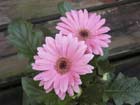
Gerbera Daisy
Scientific Name: Gerbera jamesonii
Growth Habit: A cluster-forming perennial with a short basal stem from which new leaves emerge growing plants to12 inches tall and twice as wide. The leaves are bright green, oblong and lobed to toothed and grow to 12 inches long and 4 inches wide.
Light: Plant in full sun to lightly shaded locations.
Feedings: For plantings in the ground, apply a general garden fertilizer every six to eight weeks during active growth; for container gardens, feed with a 20-20-20 or slow-release fertilizer following label instructions.
Water Needs: Prefers a moist soil; water when the surface soil begins to dry.
Ease of Culture: Medium; newer varieties appear more susceptible to rot problems.
Propagation: Start plants from cuttings or by dividing older clusters.
Hardiness: Medium; freezes cause plant decline, but shoots typically regrow from buds near the ground.
Major Problems: Powdery mildew and leaf-spot problems often are noted in local plantings and can be controlled with fungicides available at local garden centers. Grow plants in a well-drained soil to avoid root-rot problems. Control slugs, as needed, with natural baits available at garden centers.
Pruning: Remove faded flowers by twisting the stems or cutting them off near the ground. Also remove old leaves as they decline to reduce leaf-spot and rot problems.
Uses: An attractive perennial with large, colorful, daisy-type white, red, pink, orange or yellow blooms. Gerbera can be added to flower beds, but they often are short-lived because summer rains encourage root rot and decline. Gardeners often have more success growing the plants in containers that can be moved to a protected location during the rainy season. Display the container gardens on patios, porches and balconies, near entrances and along walkways.
Florida Native: No; native to South Africa.
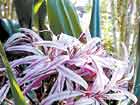
Giant Crinum Lily
Scientific Name: Crinum amabile
Growth Habit: An upright evergreen perennial growing from large bulbs that protrude above the soil line. The bright green leaves are swordlike in shape and grow to 5 inches wide and 4 feet long.
Light: Plant in full sun to light shade.
Feedings: Apply a general garden fertilizer once monthly in March, June and September.
Water Needs: Tolerates short periods of drought; grows best with a 3- to 4-inch mulch and weekly waterings.
Ease of Culture: Easy.
Propagation: Start plants by dividing older clumps.
Hardiness: Hardy; leaves may be damaged by cold, but growth resumes from the bulbs in spring.
Major Problems: Grasshoppers feed on the large green leaves. The 2-inch-long yellow and brown lubber grasshopper is especially attracted to the crinums and is best controlled by hand removal during spring when young. Red blotch, a fungal disease, causes large, rusty red spots on the leaves. Affected leaves are best removed as they develop.
Pruning: Flowering stalks are top heavy and may need staking. As the blossoms fade, the stalks are removed back to the bulb. Also, remove yellowing leaves throughout the growing season, and prune the plants in late February to remove cold damage.
Uses: Crinums are best planted in groups of three or more for their almost year-round flower clusters produced at the top of thick stems growing above the foliage. Several species, hybrids and varieties are cultivated in Florida. They open trumpet- to spider-shaped red, pink or white blossoms April through November. Add crinums to perennial gardens or use them as accents among foundation plantings and along walkways. Plants also can be grown in containers for use on the patio or balcony.
Florida Native: No: native to Sumatra.
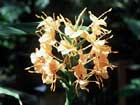
Ginger Lily
Scientific Name: Hedychium hybrid
Growth Habit: A clump-forming evergreen perennial with upright to arching stems that grow to 6 feet tall. Numerous lancelike leaves form along each stem, growing to 2 feet long and 5 inches wide.
Light: Plant in a full-sun to lightly shaded location.
Feedings: Apply a general garden fertilizer once monthly in March, June and September.
Water Needs: Tolerates short periods of drought. Grows best in moist, mulched soils that are watered weekly.
Ease of Culture: Easy.
Propagation: Start plantings by dividing older clumps.
Hardiness: Medium; damaged by frosts and freezing weather but grows back from below-ground rhizomes.
Major Problems: Chewing insects including caterpillars and grasshoppers may cause damage to the foliage but seldom need control.
Pruning: Plantings grow rapidly during the hot and rainy summer season and are ready for trimming by fall to remove out-of-bounds shoots. Plants damaged by cold also need thinning and removal of declining stems during late February as new growth begins.
Uses: Ginger lilies add tropical color to Florida landscapes. Plant near patios, along walkways and as a backdrop for flower beds. All open attractive clusters of often fragrant white, red, pink, orange or yellow flowers at the end of long main stems. Plantings begin blooming as the new shoots mature in May, and they continue blooming as additional growths are produced until late November. Plants may be added to containers for balcony and patio displays.
Florida Native: No; native to India and Malaysia.

Gloriosa Daisy
Scientific Name: Rudbeckia hirta
Growth Habit: A short-lived upright perennial growing to 3 feet tall and half as wide. The leaves are medium green, spatulate-shaped and often hairy, growing to12 inches long and 3 inches wide
Light: Grows in full sun to light shade.
Feedings: Apply a general garden fertilizer once every other month March through October.
Water Needs: Tolerates short periods of drought; grows best with a thin mulch and weekly waterings.
Ease of Culture: Easy.
Propagation: Start plants from seed.
Hardiness: Hardy.
Major Problems: Slugs and grasshoppers chew large holes in the leaves. Control by handpicking or use a natural control available from garden centers.
Pruning: Remove the old flower stems as they begin to decline to encourage additional blooms. Trim and reshape overwintered plantings in late February to remove all brown portions.
Uses: A bright addition to flower gardens, producing yellow, gold or rusty-colored single to semidouble blossoms with dark brown centers March through November. The gloriosa daisy can be directly seeded into wildflower sites or added as transplants. Plants have been found to be nematode-resistant and can be added to problem-planting sites. Gardeners also like to grow this flower in containers alone or with other annuals and perennials. The long-stemmed blossoms can be cut and used in bouquets.
Florida Native: Yes.
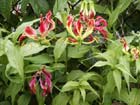
Gloriosa Lily
Scientific Name: Gloriosa superba Rothschildiana
Growth Habit: A climbing perennial lily that dies back to the ground during the fall. The leaves are dark green and grow to 6 inches long and up to 2 inches wide with a tendrillike growth at the tip.
Light: Plant in full sun to light shade.
Feedings: Apply a general garden fertilizer every other month April through September.
Water Needs: Prefers a moist soil; grows best when watered weekly.
Ease of Culture: Easy.
Propagation: Start plants by dividing the tubers of older plantings.
Hardiness: Hardy; survives as underground tubers.
Major Problems: Chewing insects may feed on the foliage but seldom need control. Aphids also may be noticed in the tips of new shoots and can be controlled with a soap spray if numerous.
Pruning: Prune as needed during the growing season to keep the plants in bounds. Remove declining plant portions during the late fall or winter months to prepare for spring growth.
Uses: An attractive accent feature that can be trained to climb a fence or a trellis. Can be used as a focal point near patios or as a backdrop for flower gardens. After a period of spring growth to produce new vines, the plants open red-and-yellow flowers arising from the leaf axils. The blossoms can be cut and used in flower arrangements. All portions of the plant are toxic if consumed.
Florida Native: No; native to Africa and India.
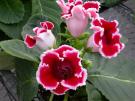
Gloxinia
Scientific Name: Sinningia speciosa
Growth Habit: A foliage plant sprouting shoots from a tuber near the soil line and growing to 12 inches tall and wide. The leaves are oval-shaped and deep green with prominent lighter green veins; they grow to 6 inches long and half as wide.
Light: Grow in bright light but not direct sun.
Feedings: Apply a 20-20-20 or similar houseplant fertilizer at half the normal rate every other week during periods of growth.
Water Needs: Keep moist during periods of active growth, watering when the surface soil begins to dry. Allow the surface soil to dry between waterings when the foliage declines and the plants enter a rest period. Begin a normal watering program when growth is again noted.
Ease of Culture: Medium; plants need special handling during rest periods.
Propagation: Start plants from leaf cuttings.
Hardiness: Tender; damaged by frosts or freezing weather.
Major Problems: Mealybugs and mites can attack the tender terminal growths. Control with a soap spray as needed. Tubers may rot if kept too wet or grown in poorly drained soils. Also keep on the dry side during rest periods.
Pruning: Remove old leaves as they start to decline. Also, pinch off faded blooms to encourage additional flowers. Remove declining shoots as plants enter a rest period and allow the soil to dry.
Uses: A popular plant for indoor display during the holiday season and the cooler winter-through-spring months. Flowers are produced in clusters atop shoots that rise above the foliage. The blossoms are large and bell-shaped, opening in white, red, pink and purple and in blends. Plants bloom for several months and then enter a rest period for six to eight weeks before beginning a new period of growth and producing flowers.
Florida Native: No: native to Brazil.
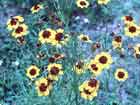
Golden Tickseed
Scientific Name: Coreopsis tinctoria
Growth Habit: An annual to short-lived perennial sprouting upright stems with whorls of foliage and flower clusters growing to 3 feet tall. The leaves are bright green, fernlike and with leaflets growing to 3 inches long and 1/4-inch wide.
Light: Plant in full sun.
Feedings: Apply a light application of a general garden fertilizer after plants begin growth and once during spring.
Water Needs: Drought-tolerant for short periods of time but grows best in moist locations. Water seeded areas or plants until established. Thereafter water only during severe drought.
Ease of Culture: Easy.
Propagation: Start plants from seed.
Hardiness: Hardy.
Major Problems: Caterpillars and grasshoppers may feed on plant foliage occasionally but seldom need control.
Pruning: After flowering and seed production, the stems gradually decline. Prune the stems to the top of the foliage or to the ground as needed to maintain attractive plantings.
Uses: An attractive addition to wildflower plantings in natural areas or perennial beds in home landscapes. The clusters of bright yellow blooms with a brown center open March through September. Golden tickseed is frequently selected for roadside plantings in Florida. The genus Coreopsis is Florida's state wildflower and many similar species plus varieties are available for home plantings.
Florida Native: No; native to the western United States.

Golden Trumpet Tree
Scientific Name: Tabebuia umbellata
Growth Habit: A rounded deciduous tree with an open branching habit; grows to 25 feet tall; loses leaves during winter, often a few weeks before flowering.
Light: Plant in a full-sun location.
Feedings: Apply a general garden fertilizer during March and June for the first three years; thereafter, trees obtain needed nutrients from decomposing mulches and nearby feedings.
Water Needs: Drought tolerant; water frequently until roots grow into the surrounding soil; established trees normally obtain adequate moisture from seasonal rains.
Ease of Culture: Easy.
Propagation: Started from seed.
Hardiness: Tender; survives frosts but often is damaged by severe freezes. Shoots form near the base and may need trimming to re-grow a single-trunk tree.
Major Problems: None reported. Make sure the trees are not pot-bound at planting time to ensure root growth into the surrounding soil.
Pruning: Maintain a central leader until the trees grow 6 to 8 feet tall. Then allow the branching to develop the rounded, open habit of growth.
Uses: The golden trumpet tree is one of a number of tabebuias used as accents and patio trees in the home landscape. It is well known for its yellow or pink flowers that fill the branches during February and March.
Florida Native: No; native to Brazil.

